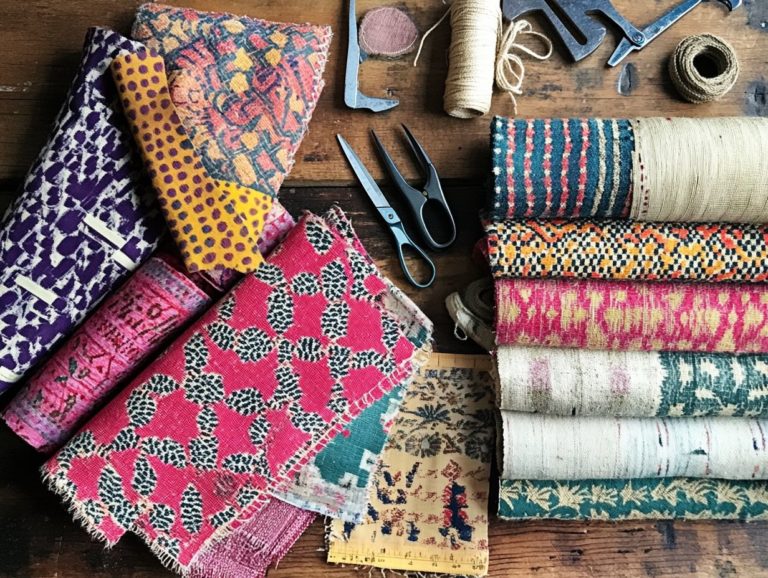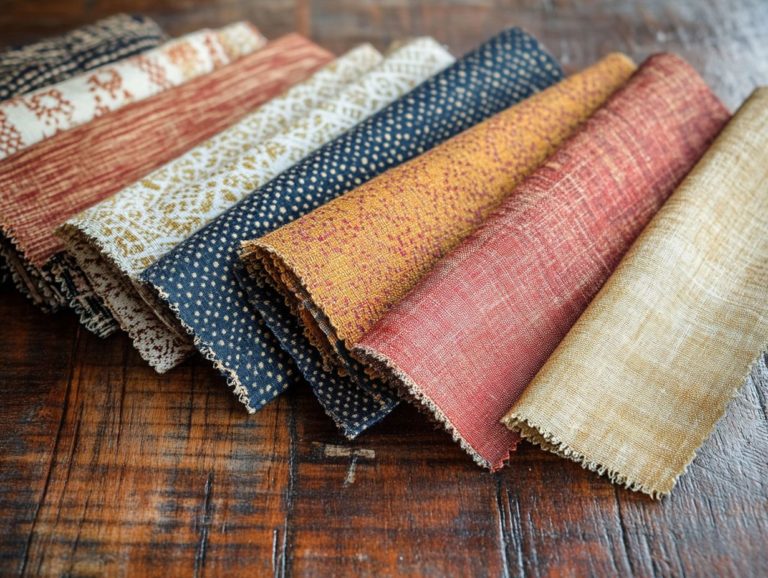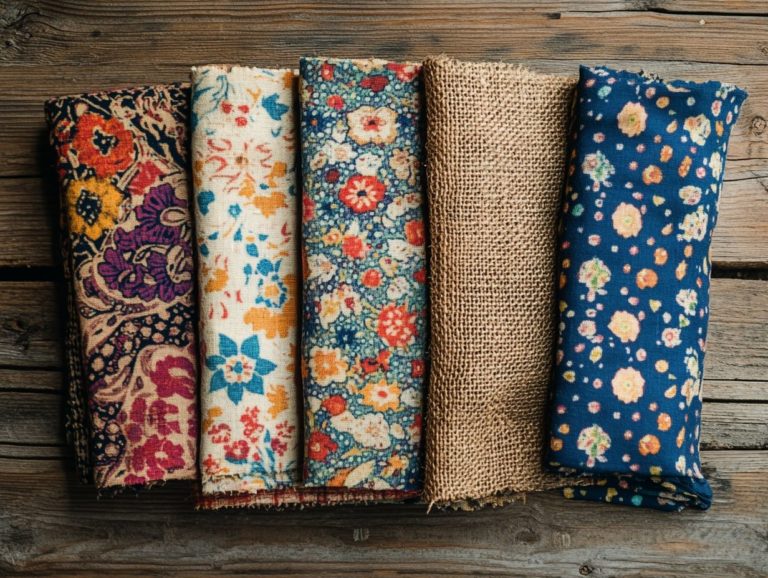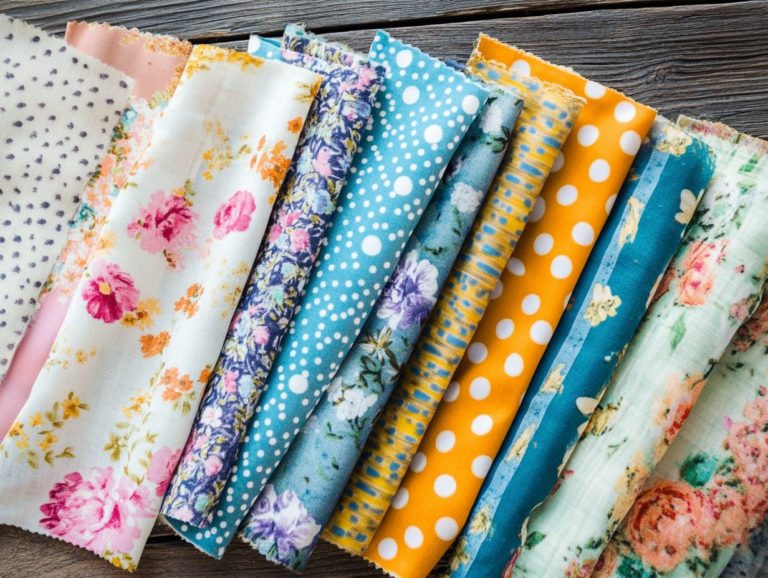How to Work with Delicate Vintage Fabrics
Vintage fabrics exude a timeless charm, each piece often infused with stories from a bygone era. Their delicate nature necessitates a level of attention and care that is both thoughtful and precise.
This article delves into the diverse types of vintage fabrics, including vintage linens and bed sheets, highlighting their unique characteristics. It offers practical techniques for handling and sewing these treasured items, guiding you through essential cleaning and storage practices to ensure you have the right tools and materials for preservation.
Discover the secrets to keeping your vintage fabrics stunning for years to come!
Contents
Key Takeaways:

- Familiarize yourself with different types of delicate vintage fabrics and their unique characteristics to determine the best approach for handling and sewing.
- Properly cleaning and storing vintage fabrics is crucial to maintaining their quality and preventing damage.
- Use specialized tools and materials when working with delicate vintage fabrics to ensure preservation and repair, and follow techniques to prevent common issues like tears and stains.
Understanding Delicate Vintage Fabrics
Understanding delicate vintage fabrics is essential if you re keen on preserving the beauty and history of these timeless treasures, including vintage linens and flour sacks. Vintage fabrics include a range of exquisite linens and charming bed sheets, each boasting unique characteristics and intricacies that echo their era.
From floral handkerchiefs to cutter quilts, these textiles often narrate stories of craftsmanship and personal history, inspiring ideas for floral handkerchief bracelets or cutter quilt hot pads. It s vital to learn the proper care and cleaning methods, along with storage solutions, to maintain their integrity.
This knowledge ensures that these fabrics can continue to inspire various crafts and upcycling projects for years to come.
Types of Fabrics and Their Characteristics
Various types of vintage fabrics possess unique characteristics, making them perfect for your fabric crafts and projects, including beautiful vintage fabric finds and thrift store treasures.
Take quilts, for example. They often feature intricate patchwork designs and soft, worn textures that exude nostalgia, making them ideal for crafting cozy throw pillows, fabric-wrapped bangles, or wall hangings that tell a story.
Then there are vintage linens, adorned with delicate embroidery and subtle patterns, just waiting to be transformed into elegant table runners, shower curtains, or napkins that add a charming touch to any dining experience.
Handkerchiefs, often embellished with lace or vibrant prints, serve not only as beautiful accents in your sewing projects but also as delightful enhancements in scrapbooking and gift wrapping. Creative ideas include handkerchief pendants or using handkerchiefs in memo boards.
Each fabric type carries a rich history, lending a unique aesthetic to your various DIY endeavors, from making Easter egg decor to crafting page pocket bookmarks.
Preparing to Work with Vintage Fabrics
When preparing to work with vintage fabrics, engage in careful cleaning and storage to ensure their longevity and usability. Vintage textiles tend to collect dirt and stains over time, making a thorough cleaning protocol essential, including a smell test to gauge freshness.
This includes the strength of sunshine cleaning, which means cleaning items in the sunlight to eliminate odors, and employing appropriate drying methods to prevent damage, such as air drying or hanging items in the shade. Whether you’re handling vintage linens or delicate fabric items, grasping the best cleaning techniques is vital for preserving their quality and charm.
This knowledge empowers you to seamlessly incorporate these treasures into various fabric crafts and creative reuse projects, enhancing your creative endeavors.
Cleaning and Storing Guidelines

Effective cleaning and storage guidelines are essential for preserving the beauty of your vintage fabrics, linens, and other cherished textiles. These items require special attention to maintain their vibrant colors and delicate textures. Proper cleaning methods and storage can help achieve this.
For stubborn stains, use Orvus WA paste, a gentle cleaner made for delicate fabrics. It s specifically formulated for sensitive materials, making it an invaluable tool in your care routine. When hand washing, use cool water and a mild detergent to prevent any potential damage.
Incorporating charming vintage storage solutions, like elegant wooden spools or fabric boxes, enhances the aesthetic appeal of your collection and provides optimal protection against dust and light. This thoughtful approach ensures that your treasured fabrics are safeguarded for years to come.
Tools and Materials for Working with Vintage Fabrics
Using the right tools and materials can make your project a success! Equip yourself with quality craft supplies like sharp scissors, reliable sewing machines, and specialized adhesives. These will assist you in various fabric crafts, whether you re creating embellished pillows, fabric-wrapped bangles, or magnetic memo boards.
Understanding which tools to use is key to a successful project and will protect your delicate vintage materials, especially during intricate sewing tasks or when creating DIY bookmarks and other handmade gifts.
Essential Supplies for Preservation and Repair
Essential supplies for preserving and repairing vintage fabrics include the right cleaning agents and tools crafted specifically for delicate materials.
Gather a selection of cleaning solutions that are gentle yet effective, ensuring they remove dirt and stains without harming the fibers. Also, consider detergent recommendations for specific needs. Access to high-quality sewing threads and needles tailored for delicate textiles is crucial for achieving the best results, especially when working with vintage fabrics.
Storage options are key in maintaining the condition of these treasured pieces. Utilize acid-free boxes, breathable muslin wraps, or other vintage fabric storage solutions to protect your items from environmental damage. It s vital to know the settings on your sewing machine, particularly the ones suitable for various fabric weights, to ensure optimal results.
Be aware of common pitfalls like skipped stitches or thread breaks, especially when working with delicate materials or during intricate tasks.
Techniques for Handling and Sewing Vintage Fabrics
Mastering the art of handling and sewing vintage fabrics is essential for preserving their quality and preventing damage. This allows you to transform them into exquisite fabric crafts, such as vintage fabric wall art or embellished pillows.
When working with delicate materials like vintage linens or handkerchiefs, gentle handling techniques are paramount. A profound understanding of the fabric’s history and characteristics is crucial, along with sewing strategies designed to minimize wear and tear.
Tips for Preventing Damage and Maintaining Quality

To prevent damage when working with vintage fabrics, it s crucial to handle and care for them carefully. This maintenance will help keep their quality intact and inspire creative reuse through upcycling.
Start by understanding the unique characteristics of each piece. The age and history can influence how the fabric behaves, guiding you in its care and upcycling potential.
Opt for gentle cleaning methods like hand washing with mild detergents or specialized textile cleaners to avoid fading or weakening those precious fibers. This ensures the longevity of your vintage fabric finds.
Air drying works best; lay items flat or hang them in a shaded area. This preserves their structure and color while preventing damage from dust or light.
When you re crafting, ensure that any tools or materials are compatible. Even small choices, like selecting the right adhesive, can significantly impact these delicate treasures.
Common Issues and Solutions for Vintage Fabric Care
Common issues with vintage fabrics, such as stains and tears, can often be addressed with the right techniques and materials. This allows cherished textiles to retain their value in your collection.
Whether it s a delicate vintage handkerchief or a beloved quilt, spotting wear and acting fast can save your vintage treasures! Understanding how to repair antique fabrics empowers you to extend their lifespan and maintain their aesthetic appeal.
Recognizing these common issues is key to keeping your vintage fabrics beautiful and inspiring further creative reuse.
How to Fix Tears, Stains, and Other Problems
Fixing tears, stains, and various issues with vintage fabrics requires a careful method that respects the material’s fragility and historical significance.
To navigate this delicate process, begin by assessing the fabric to determine its composition, condition, and potential for charming upcycle projects. Each vintage piece has a unique story, and recognizing its worth enhances your repair journey.
For minor stains, gentle spot-cleaning methods like cleaning only the stained area with a mild soap and water mixture can work wonders. Natural cleaners are often the best choice for vintage items.
When repairing tears, techniques like hand-stitching with matching thread are invaluable. This helps preserve the fabric’s integrity while keeping it an essential part of your vintage collection. Always test on a small area first to minimize risk, especially with irreplaceable vintage finds.
Here s a helpful video that shows various techniques for caring for vintage fabrics:
Frequently Asked Questions
How do I identify delicate vintage fabrics?

Different types of vintage fabrics require specific care methods. Delicate fabrics are usually lightweight, sheer, and have a fragile texture. Examples include chiffon, lace, and silk organza.
How should I handle delicate vintage fabrics?
It is important to handle delicate vintage fabrics with care. Always wash your hands thoroughly before handling, and avoid using rough or sharp tools. When cutting, use sharp scissors and cut along the grain of the fabric to prevent fraying.
How can I prevent damage to delicate vintage fabrics?
To prevent damage, store your delicate vintage fabrics in a cool, dry place away from direct sunlight. Avoid folding the fabric to prevent creases and weakening of the fibers. Use acid-free tissue paper for protection when storing.
What is the best way to clean delicate vintage fabrics?
Hand wash delicate vintage fabrics with a gentle detergent and cold water.
If heavily soiled, seek help from a professional dry cleaner.
Never use a washing machine or harsh chemicals. These can damage the delicate fibers!
How can I remove stains from delicate vintage fabrics?
Act quickly when you notice a stain. Gently blot the area with a clean, damp cloth.
Avoid rubbing, as this can make the stain worse. For tougher stains, get advice from a dry cleaner who specializes in delicate fabrics.
Can I alter delicate vintage fabrics?
It s best not to alter delicate vintage fabrics. Alterations can damage the fabric’s integrity and value.
If you must make changes, consult a professional tailor or seamstress who has experience with delicate items.






